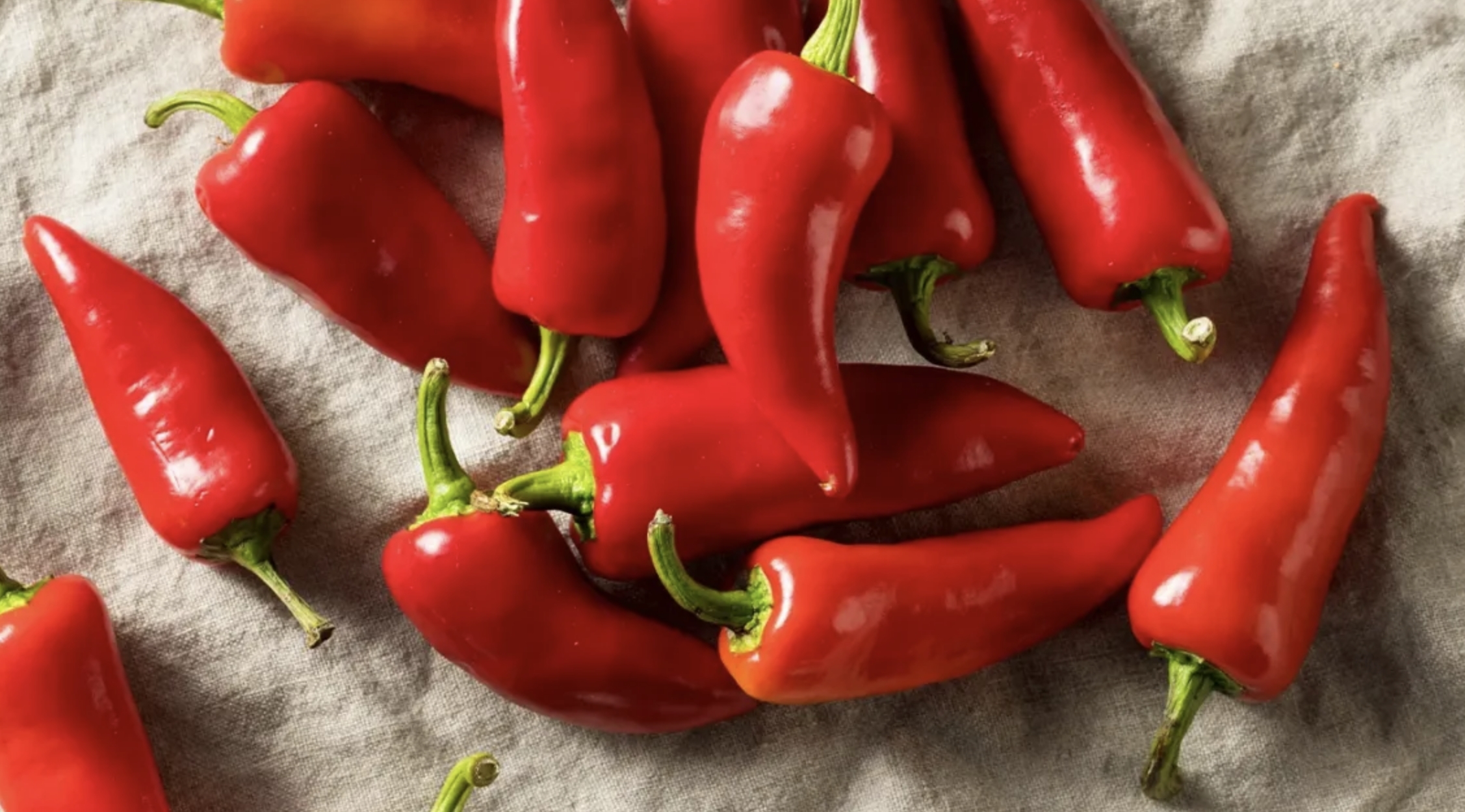You may not have heard of the ingredient capsaicin, but you’ve certainly tried it. Capsicum annuum/longum is the fruit of the tropical shrub. The spice is a favorite of many, and its flavor ranges from mild to very hot and spicy. The determining factor is the capsaicin content. The higher the capsaicin level, the hotter and spicier the red pepper.
One of the exciting effects of capsaicin is its ability to affect body temperature by stimulating an area in the brain called the ‘cooling centre’. Due to the fact that capsicums are tropical plants, it seems that nature provides the inhabitants of the tropics with a natural way of coping with high temperatures. Interestingly, although it has the ability to lower body temperature, capsaicin activates the body’s thermogenesis and warms us up.
Health benefits of taking Capsaicin
Capsaicin and pain relief benefits
Capsaicin, found in red peppers, has been studied for decades for its impressive ability to relieve pain. Creams and gels with capsaicin are used to relieve pain in arthritis, herpes zoster, and diabetic neuropathy.
When applied to the skin or when used as a dietary supplement, capsaicin stimulates nerve cells to release substance P, responsible for transmitting pain signals. At first you may feel irritation, but over time repeated application of products containing capsaicin depletes substance P and blocks the sensation of pain.
Constant intake of capsaicin can lead to the development of tolerance, with people gradually finding the taste of spicy food less pungent. Interestingly, this process may activate brain centers associated with sensory pleasure and the desire to consume spicy food. In addition, spicy food consumption may improve brain function as we age, as it stimulates various mechanisms associated with maintaining healthy brain activity.
Capsaicin and digestive benefits
Consumption of spicy foods can improve digestion. In a study published in the New England Journal of Medicine, researchers found that consuming red pepper (2.5 grams before meals) significantly reduced the symptoms of indigestion in people who suffered from this problem. In the group receiving paprika before meals, indigestion symptoms such as nausea, stomach pain and bloating were reported to be reduced by about 50% compared to the placebo group.
Interestingly, many people are afraid to consume spicy foods, believing that they aggravate stomach irritation. However, clinical studies show the opposite. Consumption of paprika prevents stomach damage, relieves stomach pain, the feeling of bloating and nausea in people with stomach irritation, and improves the symptoms of irritable bowel syndrome.
If you are one of those people who are bothered by consuming chilli, you can start with milder forms and small amounts until you gradually build up a tolerance to the hot taste.
Capsaicin and cardiovascular benefits
Capsicum has beneficial effects on the heart and blood vessels, preventing atherosclerosis or hardening of the arteries. Studies have shown that a diet rich in capsaicin is reported to lower blood cholesterol and triglyceride levels.
Capsaicin contributes to an increase in fibrinolytic activity, which is able to prevent blood clots. These clots pose a risk for the development of heart attack or stroke. This beneficial effect may explain why cultures that include copious amounts of chilli in their diet have a significantly lower incidence of heart attacks and strokes.
Capsaicin and weight loss benefits
A diet rich in capsaicin provides a variety of benefits in aiding the weight loss process. Increasing the intake of cayenne pepper can have multiple positive effects on weight regulation. Clinical studies have shown that adding cayenne peppers to the diet is a safe and natural way to boost metabolism and speed up the process of burning fat for energy. It also helps to improve blood sugar control and generally aids in weight loss.
How to use cayenne peppers?
Cayenne peppers come in a variety of forms – whole, fresh, dried, flaked or ground into a powder. Ground cayenne and paprika can be stored for up to a year in sealed glass jars – preferably in a cool, dark place away from direct sunlight.
Incorporating cayenne peppers into your diet can be easy and delicious. Here are some suggestions on how to use cayenne pepper and add more capsaicin to your dishes.
- Easy access at the table: Always keep a jar of crushed or ground cayenne pepper on the table so family members can add as they like to dinner.
- In hot cocoa: Give a spicy flavour to hot cocoa by adding a pinch of cayenne pepper. This will not only warm up the drink, but also enrich it with an interesting aroma and taste.
- Use in cooking: A small pinch of cayenne pepper can be added to any dish to give it a slightly spicy taste and irresistible aroma.
- Cook with vegetables: Create delicious vegetable marinades by adding 1/4 teaspoon cayenne pepper and two tablespoons lemon juice to three cups of cooked vegetables. This combination gives the dish not only flavor, but also incredible freshness.
By following these ideas, you can enjoy cayenne peppers in a variety of ways and introduce the benefits of capsaicin into your daily diet.
Resources:
- Kobayashi A, Osaka T, Namba Y, Inoue S, Lee TH, Kimura S. Capsaicin activates heat loss and heat production simultaneously and independently in rats. Am J Physiol. 1998 Jul;275(1):R92-8.
- Ilie MA, Caruntu C, Tampa M, Georgescu SR, Matei C, Negrei C, Ion RM, Constantin C, Neagu M, Boda D. Capsaicin: Physicochemical properties, cutaneous reactions and potential applications in painful and inflammatory conditions. Exp Ther Med. 2019 Aug;18(2):916-925.
- Zhou Y, Gao X, Small DM, Chen H. Extreme spicy food cravers displayed increased brain activity in response to pictures of foods containing chili peppers: an fMRI study. Appetite. 2019 Nov 1;142:104379.
- Tyagi S, Shekhar N, Thakur AK. Protective Role of Capsaicin in Neurological Disorders: An Overview. Neurochem Res. 2022 Jun;47(6):1513-1531.
- Bortolotti M, Coccia G, Grossi G. Red pepper and functional dyspepsia. N Engl J Med 2002;346:947–8.
- Gonzalez R, Dunkel R, Koletzko B, et al. effect of capsaicin-containing red pepper sauce suspension on upper gastrointestinal motility in healthy volunteers. Dig Dis Sci 1998;43(6):1165-71.
- Rodriguez-Stanley S, Collings KL, Robinson M, Owen W, Miner PB Jr. The effects of capsaicin on reflux, gastric emptying and dyspepsia. Aliment Pharmacol Ther 2000;14(1):129-34.
- Bortolotti M, Porta S. Effect of red pepper on symptoms of irritable bowel syndrome: preliminary study. Dig Dis Sci. 2011 Nov;56(11):3288-95.
- Szallasi A. Dietary Capsaicin: A Spicy Way to Improve Cardio-Metabolic Health? Biomolecules. 2022 Nov 29;12(12):1783.
- Sambaiah K, Satyanarayana MN. Hypocholesterolemic effect of red pepper & capsaicin. Indian J Exp Biol 1980;18(8):898-9.
- Visudhiphan S, Poolsuppasit S, Piboonnakarintr O, and Tumliang S: The relationship between high fibrinolytic activity and daily capsicum ingestion in Thais. Am J Clin Nutr 1982;35:1452-8.
- Zheng J, Zheng S, Feng Q, Zhang Q, Xiao X. Dietary capsaicin and its anti-obesity potency: from mechanism to clinical implications. Biosci Rep. 2017 May 11;37(3):BSR20170286.
- Nieman DC, Cialdella-Kam L, Knab AM, Shanely RA. Influence of red pepper spice and turmeric on inflammation and oxidative stress biomarkers in overweight females: a metabolomics approach. Plant Foods Hum Nutr. 2012 Dec;67(4):415-21.
- Ahuja KD, Robertson IK, Geraghty DP, Ball MJ. Effects of chili consumption on postprandial glucose, insulin, and energy metabolism. Am J Clin Nutr. 2006 Jul;84(1):63-9.

